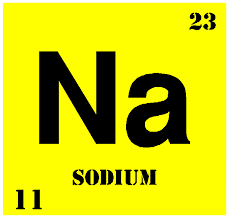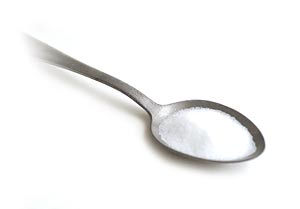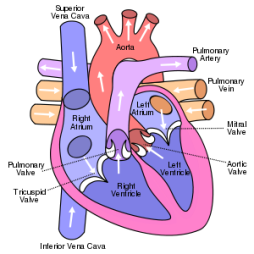Sodium
It's present in nearly all foods.
It's essential to life.
It enhances the flavor and texture of many foods.
It can be difficult to sort out all the facts about it.
You might be surprised to learn that most of the sodium in your diet doesn't come from the saltshaker.
About 75 percent of sodium comes from salt added to foods during manufacturing. Salt has many purposes in food including enhancing natural flavors, preserving freshness and improving texture.
Some common sources of sodium are canned soups, vegetables, and tomato juice; processed meats such as ham, bacon, hot dogs and lunch meats; frozen entrees and pizzas, packaged seasoned rice dishes, and pickles.

About 5 to 10 percent of sodium intake comes from salt added during cooking or at the table, and another 10 percent comes from sodium found naturally in foods.
Questions & Answers about
Salt vs. Sodium
Q = How do salt and sodium differ?
A = Table salt is 40% sodium. The other 60% is chloride. Salt (sodium chloride) is the major contributor of sodium in our diets.
Q = Should I try to eliminate foods with sodium from my diet?
A = No. Sodium is an essential nutrient. The body needs a small amount of sodium. Health experts suggest choosing a diet moderate in salt and sodium.
What is Sodium?
Sodium is an essential mineral or micronutrient which along with potassium helps to regulate the body's fluid balance. Unlike other minerals, sodium (or sodium chloride, alias salt) has a recognizable and popular taste, and is widely added to snack foods and other processed foods.
Sodium deficiency is not common, and according to some experts the average Western diet provides more than 5 times the recommended daily allowance of sodium. Excess sodium intake is linked with high blood pressure and heart disease.
Dietary sodium is measured in milligrams (mg). The most common form of sodium used is table salt, which is 40 percent sodium. One teaspoon of table salt contains 2,300 milligrams of sodium.
Salt for human consumption is produced in different forms: unrefined salt (such as sea salt), refined salt (table salt), and iodized salt. It is a crystalline solid, white, pale pink or light gray in color, normally obtained from sea water or rock deposits. Edible rock salts may be slightly grayish in color because of this mineral content.
Chloride and sodium ions, the two major components of salt, are necessary for the survival of all known living creatures, including humans. Salt is involved in regulating the water content (fluid balance) of the body. Salt cravings may be caused by trace mineral deficiencies as well as by a deficiency of sodium chloride itself. Conversely, overconsumption of salt increases the risk of health problems, including high blood pressure.
PROCESSING TABLE SALT
Since the 1950s it has been common to add a trace of sodium ferrocyanide to the brine in the United Kingdom; this acts as an anticaking agent by promoting irregular crystals. Sodium ferrocyanide has been banned in the United States and a similar ban has been discussed in the United Kingdom, but was determined to be unnecessary. These agents are hygroscopic chemicals which absorb humidity, keeping the salt crystals from sticking together.
Some anti-caking agents used are tricalcium phosphate, calcium or magnesium carbonates, fatty acid salts (acid salts), magnesium oxide, silicon dioxide, calcium silicate, sodium aluminosilicate, and calcium aluminosilicate. Concerns have been raised regarding the possible toxic effects of aluminium in the latter two compounds; however, both the European Union and the United States Food and Drug Administration (FDA) permit their use. The refined salt is then ready for packing and distribution.
What is a Diet Moderate in Sodium?
less than 2,400 milligrams per day.
Health experts realize that many people consume more than 2,400 milligrams of sodium per day. Less than the 2,400 milligram sodium goal may be unnecessarily low for many healthy people.
Other individuals on medically prescribed diets might need to consume less than 2,400 milligrams of sodium per day.
Here's what food product labels tell you about sodium:
| Sodium Free | Less than 5 milligrams sodium per serving |
|---|---|
| Low Sodium | 140 milligrams or less sodium per serving |
| Reduced/Lower Sodium | At least 25% less sodium per serving when compared to a similar food |
| No Salt Added | No salt is added during processing (when this product is normally processed with salt). The product may not be a sodium free food, so check the nutrition facts |
THE HISTORY OF SALT
In the Iron Age, the British evaporated salt by boiling seawater or brine from salt springs in small clay pots over open fires. Roman salt-making entailed boiling the seawater in large lead-lined pans. Salt was used as currency in ancient Rome, and the roots of the words "soldier" and "salary" can be traced to Latin words related to giving or receiving salt.
During the Middle Ages, salt was transported along roads built especially for that purpose. One of the most famous of these roads is the Old Salt Route in Northern Germany, which ran from the salt mines to shipping ports.
In colonial India, only the British government could produce and profit from the salt production conducted by Indians living on the coast. Gandhi chose to protest this monopoly in March 1930 and marched for 23 days with his followers. When he arrived on the coast, Gandhi violated the law by boiling a chunk of salty mud. This march became known as the Salt March to Dandi (see below). People across India began making their own salt in protest, and the march became an important milestone in the struggle for Indian independence.
Salt production also played a significant role in early America. The Massachusetts Bay Colony held the first patent to produce salt in the colonies and continued to produce it for the next 200 years. The Erie Canal was opened primarily to make salt transportation easier, and during the Civil War, the Union captured significant Confederate saltworks and created a temporary salt shortage in the Confederate states. It continues to be important to the economies of many states, including Ohio, Louisiana and Texas.
Aside from economics, salt also has cultural and religious significance. It has long been used in Shintoism to purify things, and Buddhists use salt to repel evil. In Judeo-Christian traditions, salt was used to purify people and objects, as an offering, and to seal covenants. There are numerous references to salt in the Old and New Testaments of the Bible. One of the most famous is Lot's wife, who was turned into a pillar of salt in Genesis after disobeying God's command. A rock-salt pillar that stands today on Mount Sodom is known as "Lot's Wife" (see below).
There are lots of sayings related to the use of salt. It was often traded for slaves, which is the origin of the expression "not worth his salt." Someone who is the "salt of the earth" is a dependable, unpretentious person. "Salting the earth," on the other hand, refers to an ancient military practice of plowing fields with salt so that no crops could be grown.







.svg.png)

1 comment:
Hello Allison. I just stopped by while strolling around Blogger, read a bit of your blog and decided to wish you all the best. I hope you get well, and can enjoy a nice 2009.
Best wishes from Barcelona.
Post a Comment